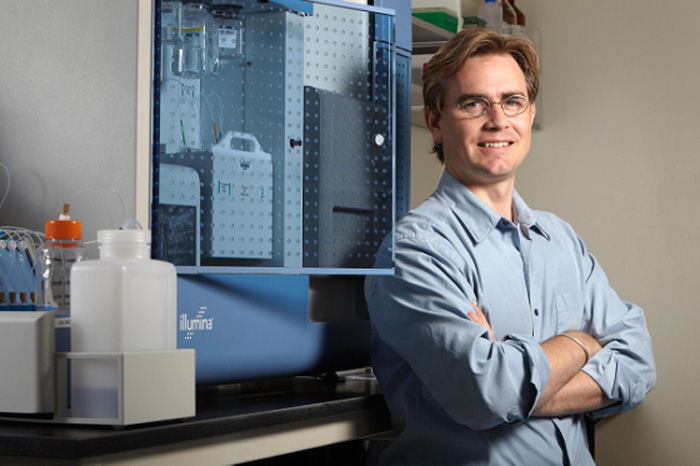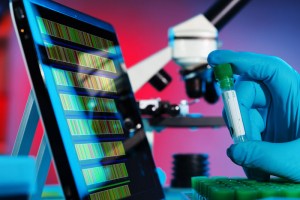UConn researchers are at the forefront of new discoveries and understanding about the smallest molecules in the body that can have a momentous impact on human health.

Brenton Graveley, professor of genetics and developmental biology at UConn Health Center and UConn’s Institute for System Genomics, and coauthor of a recent review article in Molecular Cell with fellow UConn postdoctoral researcher Alex Plocik, explains how government-funded research consortia are using advances in DNA sequencing technology to unlock the mysteries surrounding diseases and disorders. By sharing this DNA sequence information with other researchers, new discoveries can be made even faster. Graveley is a lead investigator in one such government-funded research consortium, the ENCODE project.
Sequencing involves mapping out the order of molecules within DNA, which is the blueprint or building blocks of life because it contains all of the genetic instructions needed to build and maintain an organism. “DNA sequencing has changed the whole landscape of science and biology,” Graveley says. “It’s exploding exponentially, and there’s no end in sight.”
Understanding each individual’s DNA sequence allows doctors to develop treatments and cures specifically targeted to that person’s needs. “That’s the promise of personalized medicine,” he explains. “People may come in with totally unknown symptoms, and by sequencing their DNA we could use this information to treat them on an individual basis.”
Today’s computer technology has made interpreting sequence data possible. In 2003, the complete human genome was sequenced through the U.S. government’s Human Genome Project, taking 13 years and costing about $3 billion. The project identified all of the more than 20,000 genes in human DNA and determined the sequences of the three billion chemical base pairs that comprise it.

Today, this same sequencing can be done by a stand-alone laboratory in one day for several thousand dollars. “This research provides an opportunity for doctors to do testing on people with a certain disorder to study the genes which, when mutated, caused that disease,” he says. “It’s a game-changer.”
The 1997 sci-fi film Gattaca imagined a world where people put their finger on a sensor and their entire DNA was analyzed on the spot. “The technology is in development right now to allow that to happen,” Graveley explains. “The science fiction that was dreamed up in a movie is essentially coming to be.”
Earlier this year, the University of Connecticut and the State of Connecticut introduced Next Generation Connecticut, a plan to expand research, education and innovation in the science, technology, engineering and math (STEM) studies at UConn. Designed to put UConn at the forefront of technology and research, the program is expected to benefit the entire state by creating new jobs, innovations and start-up companies.
“There is a large consortium of researchers who are generating rich data – so rich that we can’t analyze all aspects of it,” Graveley says. “What this means is that researchers can download and analyze data to make new discoveries about how biology works, without having to do any experiments. One of the goals of Next Generation Connecticut is to create these jobs and train people to have the knowledge to analyze data in ways that haven’t been done before.”
UConn researchers are joining forces with genomics medicine experts at Jackson Laboratory, which is building a $1.1 billion research facility on the Health Center’s Farmington campus, to make further discoveries in the area of human genomics and to advance the computational tools for interpreting the data coming from this type of research. To accelerate research in this interdisciplinary field, UConn has brought together nine of its schools/colleges and the Jackson Laboratory to create the Institute for Systems Genomics.
Graveley and Plocik teamed with other experts on a second review article recently published in the journal Cell that covers a related topic involving techniques to splice RNA, which acts as a messenger to carry out instructions from DNA. It serves as another example of the wealth of genetics research and expertise at UConn.
DNA sequencing can’t be done for every person quite yet, because the process is still expensive and because doctors need to be trained on how to use the information that sequencing provides, since the science is new to them, too. And there is still a large amount of information in DNA that researchers still don’t understand. But this is rapidly changing.
“Sequencing technology will eventually apply to everyone,” Graveley says. “Somewhere down the road, maybe in 10 years or even longer, every person born will have their genome sequenced and have it be a permanent part of their medical record. This information can be used to figure out what’s wrong if they become sick and how they can be treated. This is an exciting time.”
Follow the UConn Health Center on Facebook, Twitter and YouTube.



